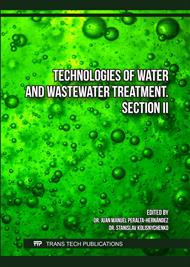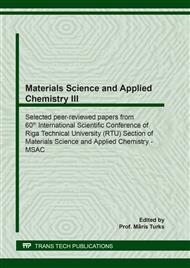[1]
K. Grubel, A. Machnicka, E. Nowicka, S. Wacławek, Mesophilic-thermophilic fermentation process of waste activated sludge after hybrid disintegration, Ecol. Chem. Eng. S. 21 (1) (2014) 125-136.
DOI: 10.2478/eces-2014-0011
Google Scholar
[2]
Ö. Arvas, S. Z. Çelebi, I. H. Yilmaz, Effect of sewage sludge and synthetic fertilizer on pH, available N and P in pasture soils in semi-arid area, Turkey. African J. Biotechnol. 10 (73) (2011) 16508-16515.
DOI: 10.5897/ajb11.110
Google Scholar
[3]
H. Kahiluoto, M. Kuisma, E. Ketoja, T. Salo, J. Heikkinen, Phosphorus in manure and sewage sludge more recyclable than in soluble inorganic Fertilizer, Environ. Sci. Technol. 49 (2015) 2115-2122.
DOI: 10.1021/es503387y
Google Scholar
[4]
J. Wierzbowska, S. Sienkiewicz, S. Krzebietke, P. Sternik, Sewage sludge as a source of nitrogen and phosphorus for Virginia fanpetals, Bulg. J. Agric. Sci. 22 (2016) 722-727.
Google Scholar
[5]
P. Samaras, C. Papadimitriou, A. Haritou, Z.A. Anastasios, Investigation of Sewage Sludge Stabilization Potential by the Addition of Fly Ash and Lime, J. Haz. Mat. 154 (2008) 1052-9.
DOI: 10.1016/j.jhazmat.2007.11.012
Google Scholar
[6]
M. Zupancic, P. Bukovec, R. Milacic, J. Scancar, Critical evaluation of the use of the hydroxyapatite as a stabilizing agent to reduce the mobility of Zn and Ni in sewage sludge amended soils, Waste Manage. 26 (12) (2006) 1392-9.
DOI: 10.1016/j.wasman.2005.12.007
Google Scholar
[7]
M. Ros, M.T. Hernandez, C. García, Bioremediation of soil degraded by sewage sludge: effects on soil properties and erosion losses, Environ. Manage. 31 (6) (2003) 741-7.
DOI: 10.1007/s00267-002-2839-8
Google Scholar
[8]
M. Bożym, G. Siemiątkowski, Characterization of composted sewage sludge during the maturation process: a pilot scale study, Environ. Sci. Pollut. Res. Int. 25 (34) (2018) 34332-34342.
DOI: 10.1007/s11356-018-3335-x
Google Scholar
[9]
M. Suchowska-Kisielewicz, A. Jędrczak, The Evaluation of Indicators Used to Assess the Suitability of Agricultural Waste for Fermentation, Int. J. Environ. Res. Public Health. 16 (11) (2019) 1889.
DOI: 10.3390/ijerph16111889
Google Scholar
[10]
M. Nikaeen, A.H. Nafez, B. Bina, B.F. Nabavi, A. Hassanzadeh, Respiration and enzymatic activities as indicators of stabilization of sewage sludge composting, Waste Manag. 39 (2015) 104-10.
DOI: 10.1016/j.wasman.2015.01.028
Google Scholar
[11]
F. Camiña, C. Trasar-Cepeda, F. Gil-Sotres, C. Leirós, Measurement of dehydrogenase activity in acid soils rich in organic matter, Soil Biol. Biochem. 30 (8-9) (1998) 1005-1011.
DOI: 10.1016/s0038-0717(98)00010-8
Google Scholar
[12]
L. Zorza, M. Kalnins, D. Gudra, D. Fridmanis, A. Rapoport, O. Muter,. Evaluation of the changes in bacterial community structure and its activity in the presence of Saccharomyces cerevisiae and benzalkonium chloride, (2019) (Under review).
DOI: 10.1088/1755-1315/987/1/012010
Google Scholar
[13]
O.T. Okareh, O.D. Enesi, Removal of Heavy Metals from Sewage Sludge Using Sugarcane Waste Extract, J. Sci. Res. Rep. 6 (6) (2015) 439-450.
DOI: 10.9734/jsrr/2015/16967
Google Scholar
[14]
K. Malińska, Application of a modified OxiTop® respirometer for laboratory composting studies, Arch. Environ. Protect. 42 (1) (2016) 56-62.
DOI: 10.1515/aep-2016-0007
Google Scholar
[15]
M. Davids, D. Gudra, I. Radovica-Spalvina, D. Fridmanis, V. Bartkevics, O. Muter, The effects of ibuprofen on activated sludge: Shift in bacterial community structure and resistance to ciprofloxacin, J. Haz. Mat. 340 (2017) 291-299.
DOI: 10.1016/j.jhazmat.2017.06.065
Google Scholar
[16]
H.K. Ahn, T.L. Richard, T.D. Glanville, Optimum moisture levels for biodegradation of mortality composting envelope materials, Waste Manag. 28 (8) (2008) 1411-1416.
DOI: 10.1016/j.wasman.2007.05.022
Google Scholar



